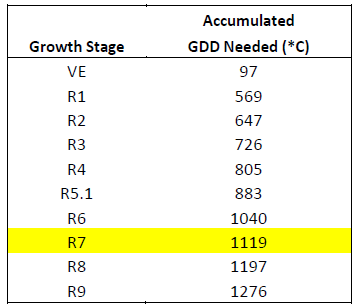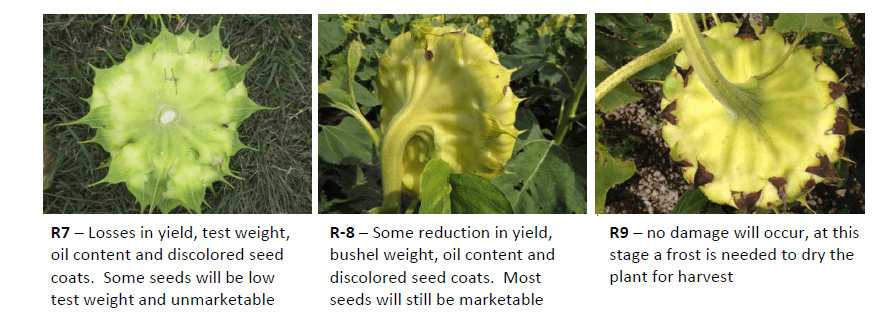Frost Impact on Sunflowers

Frost anytime before the sunflower crop reaches physiological maturity (R9) can cause damage. Once sunflowers reaches the R7 stage (ray petals have dropped, back of head starting to turn yellow), sunflower can withstand temperatures as low as -4° C, but temperature, duration and crop stage will influence the type and amount of damage. A killing frost in sunflowers is considered to be -4 to -5° C for 6 or more hours, as this low temperature for the extended period is required to penetrate the thick layer in the back of the sunflower head and start the dry down process. The following will attempt to describe what happens when a frost occurs prior to the R-9 growth stage.
How Much Time is Needed to Reach R9? Sunflower development is driven by temperature and accumulation of temperatures during the day/night. The formula to convert the daily max/min temperature to a sunflower GDD is ((Tmax + Tmin)/2) – 6.7° C. If the Tmax or Tmin is at or below 6.7° C, then use the 6.7 temperature in the formula instead of the real number. For example, with a 17° C max and a 4° C min temperate = ((17+6.74)/2 – 6.7) = 5 sunflower GDD. From Table 1, the development model indicates it needs 79 ‘sunflower GDD’ to reach R9 from R8 and 157 ‘sunflower GDD’ from R7. On average, throughout September most sunflower growing areas are accumulating on average 7 ‘sunflower GDD’ per day, meaning: R7 (start) to R9 = 22 days R8 (start) to R9 = 11 days

Table 1: Sunflower Growth and Development Model based on GDD from www.ag.ndsu.edu Link to document PDF here Information from this article was provided by Manitoba Agriculture and Resource Development and National Sunflower Association of Canada

